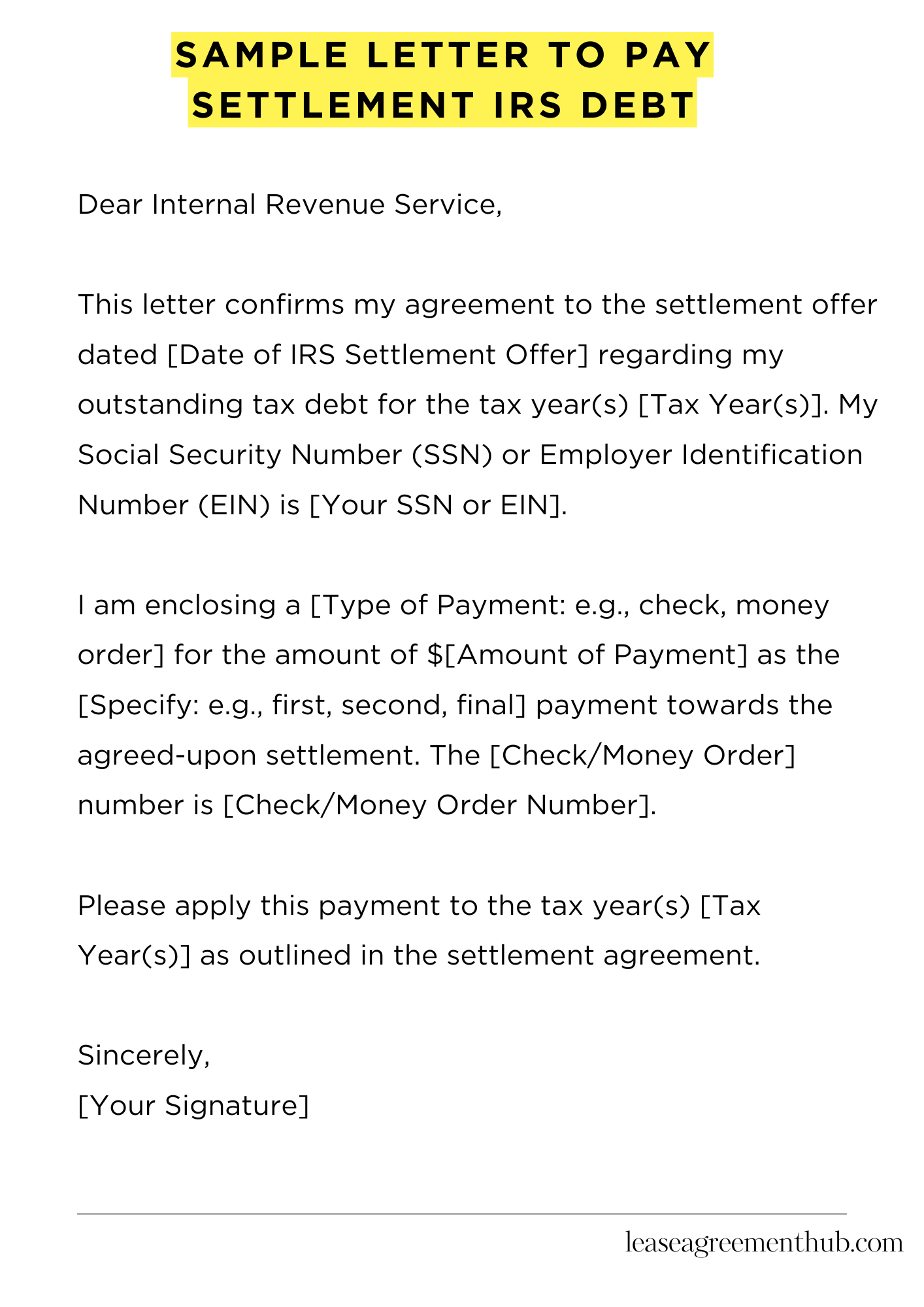A “Sample Letter To Pay Settlement IRS Debt” is a letter you send to the IRS. You use it to agree to their settlement offer. This usually happens when you owe back taxes. You’ve negotiated a payment plan or a reduced amount.
Need to write this letter? You’re in luck. We’ve got you covered. We know dealing with the IRS can be stressful.
This article provides sample letters. Use them as a guide. They will help you craft your own winning letter. Let’s make this process easier.
Sample Letter To Pay Settlement Irs Debt
[Your Name]
[Your Address]
[Your City, State, Zip Code]
[Your Phone Number]
[Your Email Address]
[Date]
Internal Revenue Service
[IRS Address]
[IRS City, State, Zip Code]
Subject: Payment for IRS Debt Settlement – [Your Name] – [Your SSN or EIN]
Dear Internal Revenue Service,
This letter confirms my agreement to the settlement offer dated [Date of IRS Settlement Offer] regarding my outstanding tax debt for the tax year(s) [Tax Year(s)]. My Social Security Number (SSN) or Employer Identification Number (EIN) is [Your SSN or EIN].
I am enclosing a [Type of Payment: e.g., check, money order] for the amount of $[Amount of Payment] as the [Specify: e.g., first, second, final] payment towards the agreed-upon settlement. The [Check/Money Order] number is [Check/Money Order Number].
Please apply this payment to the tax year(s) [Tax Year(s)] as outlined in the settlement agreement.
I understand that failure to adhere to the payment schedule outlined in the settlement agreement may result in the reinstatement of the original debt amount.
Thank you for your attention to this matter. Please contact me if you require any further information.
Sincerely,
[Your Signature]

How to Write a Letter To Pay Settlement IRS Debt
1. Subject Line: Brevity and Clarity Are Paramount
The subject line is your initial handshake. It should be concise and unambiguous. Avoid overly verbose pronouncements.
- Example: Offer in Compromise – [Your Name] – [Tax Year(s)]
- Including your name and the relevant tax year(s) provides immediate context.
2. Salutation: A Modicum of Formality
Begin with a respectful salutation. While you might feel exasperated, maintain a professional tone.
- Option 1: Dear Internal Revenue Service,
- Option 2: To Whom It May Concern:
- Avoid using specific names unless you have a direct contact.
3. Introduction: State Your Purpose Forthrightly
Clearly and immediately state the purpose of your letter. Don’t bury the lede.
- “I am writing to formally submit an Offer in Compromise (OIC) to resolve my outstanding tax liability for the tax year(s) [insert year(s)].”
- Mention that you are proposing a settlement to resolve your debt.
- Briefly allude to your financial constraints.
4. Body Paragraph 1: Detailing Your Fiscal Predicament
This section requires transparency. Explain your current financial situation with forthrightness.
- Describe your income, assets, and liabilities.
- Highlight any extenuating circumstances that contribute to your inability to pay the full amount.
- Be candid, but avoid excessive emotionality. Present facts.
5. Body Paragraph 2: Proposing Your Settlement Amount
Specify the exact amount you are offering to settle your debt. Justify your proposal, demonstrating it reflects your ability to pay.
- “I am offering a settlement of [dollar amount] to resolve this debt.”
- Explain how you arrived at this figure, referencing your income, expenses, and asset valuation.
- Reinforce that this offer represents the maximum amount you can reasonably afford.
6. Request for Consideration: A Plea for Empathy
Politely request the IRS to consider your offer. Express your earnest desire to resolve the matter amicably.
- “I respectfully request that the IRS carefully consider my Offer in Compromise.”
- Reiterate your commitment to fulfilling your tax obligations to the best of your ability.
- Express your hope for a positive resolution.
7. Closing: Sign-Off with Professionalism
End your letter with a professional closing and your contact information.
- Closing: Sincerely, or Respectfully,
- Include your full name, address, phone number, and email address.
- Keep a copy of the letter and any supporting documentation for your records.
Frequently Asked Questions: Sample Letter to Pay Settlement IRS Debt
This section addresses common inquiries regarding drafting a sample letter to the IRS for paying a settlement debt. Understanding the nuances of this process can ensure accurate communication and efficient resolution.
What information should I include in the settlement payment letter?
Your letter should include your full name, address, Social Security number or Employer Identification Number (EIN), the tax year in question, the type of tax (e.g., income tax, payroll tax), the settlement amount, and the payment method.
Where should I send the settlement payment letter and payment?
The address for sending your letter and payment varies based on the IRS office handling your case. Refer to your settlement agreement or contact the IRS directly to confirm the correct mailing address.
How should I make the payment for the IRS settlement?
Payments can be made via check, money order, or electronically through the IRS website (IRS.gov). Make checks or money orders payable to the U.S. Treasury and include your identifying information.
What if I cannot pay the full settlement amount immediately?
If you cannot afford the full settlement amount, contact the IRS immediately to discuss potential payment options, such as an installment agreement. Provide a detailed explanation of your financial hardship.
Should I send the payment with the settlement agreement?
No, send the payment and payment letter only after the IRS has formally approved your settlement agreement. The payment letter serves to acknowledge and document your payment towards the approved settlement.
Related: